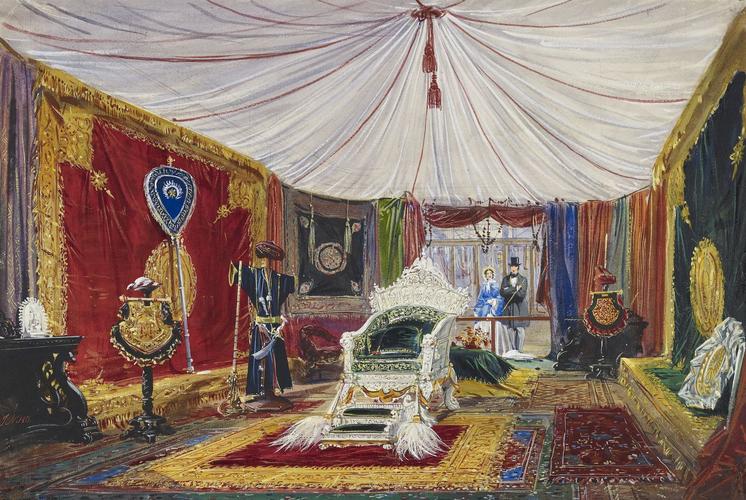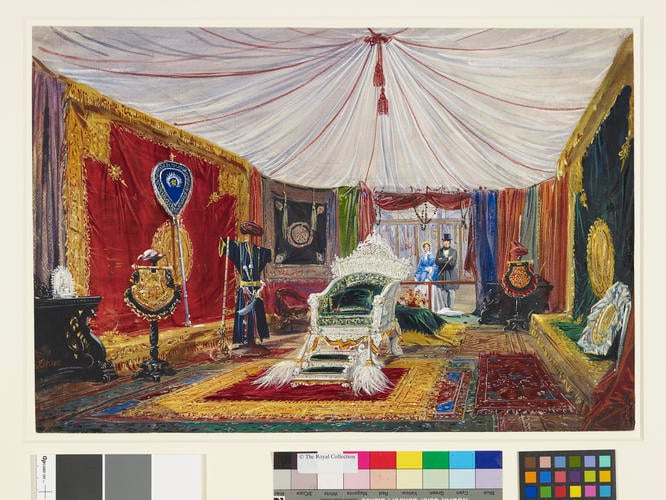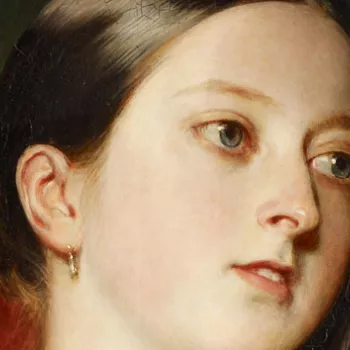The Great Exhibition: India No.I dated 1851
Watercolour and bodycolour over pencil | 35.0 x 51.5 cm (sheet of paper) | RCIN 919968
-
A watercolour depicting the Ivory Chair of State and footstool presented to the Queen by the Raja of Travancore, part of the Indian display at the Great Exhibition. Behind it is seen the crown of the King of Oudh, and the costume of the Raja of Bundi is up on the left. Signed and dated at lower left: JN 1851. For other views of the Indian section, see RCINs 919943, 919944, 919942, 919973, 919969 and 919951.
In his capacity as President of the Society of Arts, Prince Albert set up a committee to organise exhibitions with the aim of improving British industrial design. An exhibition in Birmingham in 1849 was followed by the first truly international exhibition, the Great Exhibition of Products of Industry of All Nations, held in Joseph Paxton's 'Crystal Palace' in Hyde Park, London, in the summer of 1851. Half the exhibition space was devoted to British manufacturing, and the other half was offered to foreign countries to display their achievements and specialisms. Six million people visited the exhibition to see over 100,000 exhibits from around the world, divided broadly into raw materials, machinery, manufactures and the fine arts; Queen Victoria herself visited no fewer than thirty-four times. The substantial profits were used to establish the South Kensington Museum, renamed the Victoria and Albert Museum in 1899. The Queen wrote to her uncle Leopold, King of the Belgians, that the inaugeration of the Great Exhibition was the "greatest day in our history."
Many countries had dedicated areas at the Great Exhibition. This watercolour by Joseph Nash shows an exotic tented space in the India section. Clearly visible in the centre is the ivory and jewel-encrusted throne and that was presented to Queen Victoria by the Maharaja of Travancore. When the Queen became Empress of India in 1876 she chose to be shown seated on this throne for the official photograph.
This is one of a series of forty-nine watercolours commissioned by Queen Victoria and Prince Albert illustrating the various national sections and displays of materials and objects at the Exhibition. Joseph Nash made forty-three of them, and Louis Haghe painted six. The watercolours were commissioned for the purpose of reproduction as chromolithographs, and thus were a permanent visual record of the temporary spectacle. These chromolithographs were published by Messrs Dickinson of Bond Street in two volumes with accompanying letterpress descriptions in 1854 as Dickinson's Comprehensive Pictures of the Great Exhibition of 1851.Provenance
Commissioned by Queen Victoria and Prince Albert
-
Medium and techniques
Watercolour and bodycolour over pencil
Measurements
35.0 x 51.5 cm (sheet of paper)
Other number(s)
RL 19968










